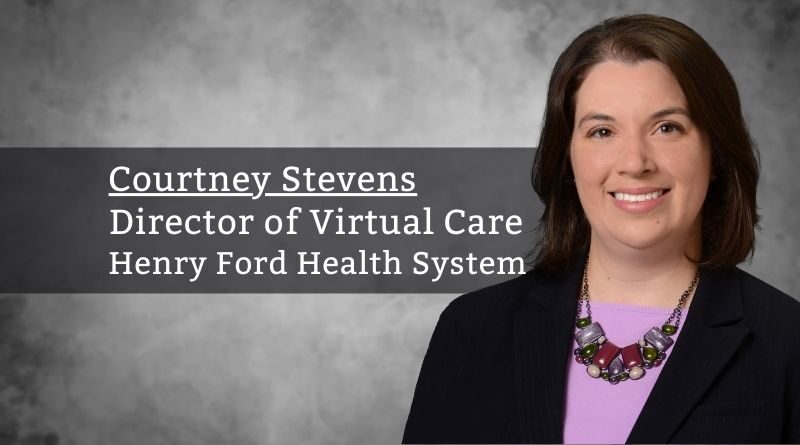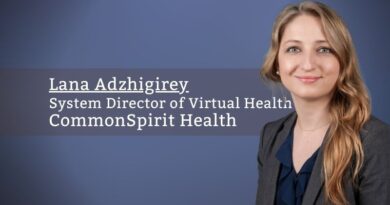Virtual Care for the Era Ahead: Four Lessons Learned
By Courtney Stevens, Director of Virtual Care, Henry Ford Health System
Throughout the pandemic, consumers have changed their expectations for doing business in every aspect of their lives, including banking, shopping, dining, entertainment, worship, and most of all, healthcare. In 2019, prior to the COVID-19 pandemic, Henry Ford Health System providers conducted just over 17,000 virtual encounters, or about 65 per day. Once the COVID-19 pandemic hit Detroit in mid-March 2020, that number skyrocketed to more than 1,500 per day, ending 2020 with over 420,000 virtual encounters. Consumers’ needs and expectations have risen, and our job is to meet them. Within the Henry Ford Health System, this means challenging healthcare delivery norms and focusing on customer experience to create what we have termed “Radical Convenience.”
This drastic increase in the delivery of virtual care (including Video Visits, E-visits, E-consults, and more) came with its fair share of lessons learned, which Henry Ford has embraced and leveraged to set priorities and our path forward. Here are some of the bigger lessons.
Henry Ford was driving our path forward to enhance our virtual care strategy before the pandemic and recognized the value and benefit that it could bring to our customers with the right technological innovation, integration, and support.
Having an Enterprise Virtual Care Approach is Key
In 2015, Henry Ford’s leadership made the strategic decision to dedicate resources and structure to the organization and standardization of virtual care, then known as telehealth. Six years later, the system-wide Virtual Care Department not only drives the virtual care strategy for the health system, but also aligns and supports every aspect of virtual care integration and enablement. This team acts as project managers and strategic advisors/consultants in the implementation of virtual care capabilities. It maintains standard build and operational models to ensure standardization from hardware/software to EMR integration to training. They also act as subject matter experts in telehealth billing, regulations, and facilitate knowledge sharing throughout the organization. Without all of this in place, we would not have successfully scaled up during the pandemic.
Entree to Virtual Care Needs to be Seamless for the Patient
For patients, the virtual care experience itself begins before they ever see a provider. We strive to attract, engage, and retain customers by providing an exceptional digital experience that allows them to engage with Henry Ford where, when, and how they prefer. An essential driver of virtual care utilization is for the health system to build a frictionless “digital front door,” ensuring that patients and providers can both navigate their way through it, and more importantly, find a connected, accessible, easy-to-navigate experience once on the other side. To make this happen, for example, our care team can send a direct hyperlink to the patient if they are having trouble starting their appointment. In addition, we have added a dynamic patient video visit instruction wizard to our website. After the patient answers a couple of quick questions about the type of device they are on, the decision tree lands them to the quick and easy steps with images that help them get through their virtual connection, as well as description patient instruction videos.
With the use of various voice of the customer tools, such as market insight surveys, Patient and Family Advisory Councils, and patient satisfaction survey comments, we gauge how we are doing and where we need to focus our efforts in our path forward.
Don’t Forget to Collaborate
Virtual care is not a self-contained strategy. It cannot be accomplished without ensuring internal and external collaboration and coordination of care to align the best course for everyone. Critical internal collaboration includes not only the operational and clinical stakeholders, but also information technology/security, market leadership, population health, patient outreach, and corporate support services. In addition to internal collaboration, the importance of external collaboration such as partnering with vendors, other health systems/providers, community organizations, and employers helped to bring our trusted and innovative aligned virtual and “brick and mortar” services to patients and create a collaborative healthcare ecosystem that now expands to anywhere the patient may be.
Ongoing Challenges Are – Always — to Be Expected
This innovation and discovery do not come without challenges. Some of these include maintaining adoption and standardization throughout the organization as the dust settles from the pandemic, continuing pressure to evolve or push innovation in healthcare design and hospital strategy, identifying the appropriate use of telehealth at the service line or specialty level, mounting security and privacy concerns, honoring patient preference, confronting digital inequities (i.e., telehealth literacy, accessibility, compatibility, diversity, equity, inclusion), and reacting to the ever-changing government, licensure, and reimbursement landscape. This list isn’t short. Add to it one final item – “the unknown.” By being ready for change and challenges, and having a foundation and collaborative partners in place, we are prepared to tackle these issues.
There is an old saying that there are decades when nothing happens, and then there are weeks when decades happen. Henry Ford was driving our path forward to enhance our virtual care strategy before the pandemic and recognized the value and benefit that it could bring to our customers with the right technological innovation, integration, and support. But the pandemic proved the value of virtual care to the American healthcare system at large. With this solid foundation, Henry Ford’s application of virtual care during the COVID-19 pandemic provides a working model of steps other organizations can take to maximize their telehealth and telemedicine programs. Virtual care is no longer experimental. It has moved to the mainstay in the healthcare ecosystem, and to succeed, organizations must evolve and embrace it.



